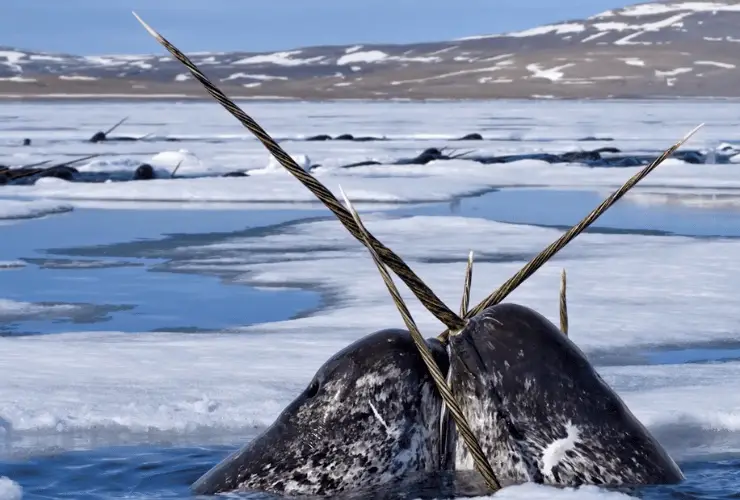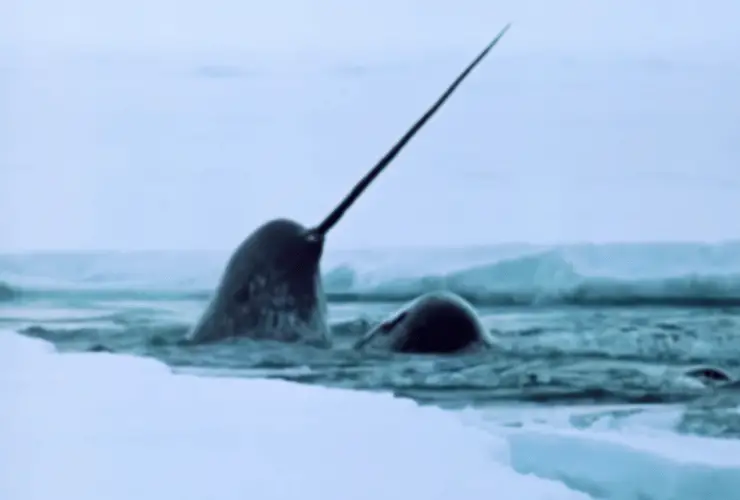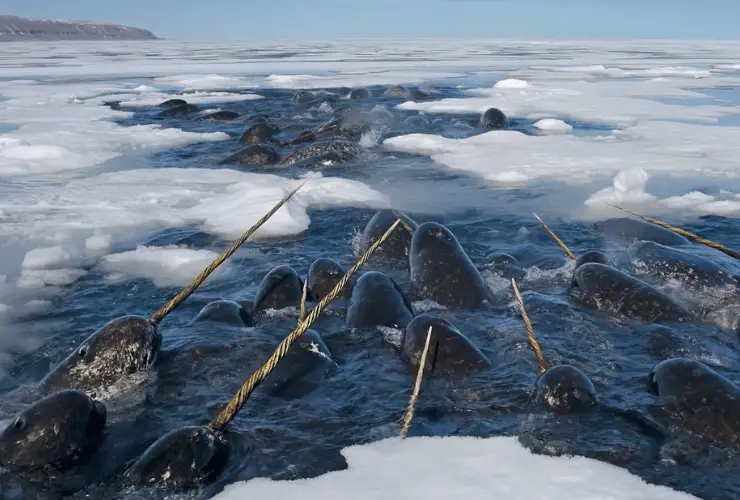Narwhals, which are marine mammals, live in Arctic waters. They spend their lives in Norway, Greenland, Russia, and Canada. More significantly, they live most of their lives in the region of Baffin Bay and Davis Strait, where they can breathe through ice cracks. Baffin Bay is situated between Canada and Western Greenland.
Greenland halibut is the primary food source for narwhals in these chilly seas, and the presence of this food source helps narwhals live there.
Local populations in the Arctic value narwhals as part of their culture, which is crucial to the general health of the marine environment. However, they depend on sea ice and are vulnerable to the direct effects of climate change.
Where Do Narwhals Live?

We already mentioned that narwhals, marine mammals, live in the Arctic waters of Canada, Greenland, Norway, and Russia.
The Baffin Bay-Davis Strait between western Greenland and Canada is where most of the world’s narwhals spend up to five months resting under the sea ice.
In the Arctic Ocean’s Atlantic and Russian regions, narwhals may be found in the following places:
- Canadian Arctic Archipelago
- Northern Hudson Bay
- Hudson Strait
- Baffin Bay
- The east coast of Greenland and
- A region that stretches from eastern Russia to Greenland’s far north (170° East).
Additionally, they are dispersed across the North Atlantic Ocean and can dive to depths of up to a mile and a half to collect their prey.
Where Can You See Narwhals?
Most narwhal sightings occur in the Arctic, specifically in the chilly waters off Canada and Greenland.
One of the best times to watch narwhals is in May and June when they migrate annually to their summer feeding sites.
Visitors frequently need to go to the edge of the ice to observe narwhals in the wild, where they might spend hours or even days watching them with binoculars.
Note: Take guided tours or engage with local Inuit tour operators who know the finest viewing locations. This way, you can have a responsible and helpful experience.
How Rare Is It To Find a Narwhal?
If we talk about how hard or rare it is to find Narwhals, they are difficult but possible, with a population estimated at over 80,000.
While earlier estimates of the global narwhal population were fewer than 50,000, recent estimates mention that the population has increased to more than 170,000.
This new estimate has made the population concern status for narwhals ‘least concerned.’
Did you know? One of the interesting things about narwhals is that they spend their winter season in the Baffin Bay-Davis Strait area. They stay there for 5 months or more below the sea ice.
Although narwhals have never been successfully kept in captivity, they can be seen in the wild in places such as the floe edge of Lancaster Sound and Baffin Bay in Canada’s High Arctic.
How To See Narwhals in Nunavut?

Narwhals are a unique whale species that live year-round in the Arctic waters of Nunavut. If you want to see narwhals in Nunavut, here are some tips:
- Location: Narwhals are less common than beluga whales, but they can still be found in places like Lancaster Sound, Pond Inlet, Arctic Bay, and Naujaat.
- Time of Year: In the summer, narwhals come very close to the seashore, making it a great chance to view them. The annual migration to their summer feeding grounds in May and June is also a good time to spot them.
- Guided Tours: Another thing you can do to see Narwhals In Nunavut is to get help from a local guide. The guides are available in Pond Inlet (the best place to see large pods of narwhal) or Arctic Bay areas.
Why Are Narwhals So Hard To Find?
There are a number of factors that contribute to narwhals’ reputation for hiding and difficulty in research. Their migrating behavior is one of the primary causes.
Narwhals migrate west and east, making it difficult for the average traveler to see them if they live in the Arctic.
Narwhals are also challenging to locate and study since they spend most of their time under the chilly Arctic Ocean, where they are known to be cautious and skittish.
They spend most of the year living in the cracks of thick pack ice while evading boats and helicopters. They can’t be herded towards the beach like belugas.
Additionally, tagging them with air rifle-fired transmitters is not useful due to their small size (for whales), extreme speed, and debilitating agility.
In addition to spending a lot of time offshore and being remote from people, narwhals live in an Arctic habitat that is changing quickly.
Despite these difficulties, researchers have been able to study narwhals by following their travels via satellite and looking at the contents of their stomachs.
Can Narwhals Live In Warm Water? Why?

Because of their adaptation to living in chilly seas, narwhals rarely go to warmer regions where they could encounter more predators or compete with other whale species for food.
All year long, narwhals spend their lives in water consistently at or below freezing. In the Arctic, narwhals avoid locations where warm Atlantic water flows (>4°C), probably affecting their travel patterns and habitat preferences.
Thus, it seems improbable that narwhals could survive in warm water.
In winter and the summer, narwhals travel great distances to different locations, following swiftly changing ice conditions.
During the summer, narwhals spread out across a vast area farther north in the Canadian High Arctic archipelago and gather in bays.
How Do They Adapt In The Cold Water?
Narwhals have remarkable adaptations that allow them to thrive in the cold waters of the Arctic. These adaptations include both anatomical and physiological features.
The following are a few of the adaptations that enable them to endure the chilly waters:
- Thick blubber layer: Narwhals have a thick layer of blubber under their skin. They can retain the heat produced by cellular metabolism thanks to the insulation that makes up 40% of their mass.
The blubber layer also provides buoyancy, which helps narwhals conserve energy while swimming.
- Streamlined body: Narwhals have a streamlined body shape that reduces the surface area exposed to cold water.
- Countercurrent heat exchanger: Narwhals have a close arrangement of arteries entering the flippers and veins leaving them, which helps to conserve heat by transferring heat from the warm arterial blood to the cooler venous blood.
- Flexible rib cage: Narwhals have a flexible rib cage that allows them to dive to great depths.
Frequently Asked Questions (FAQs)
Can Narwhals Be in Captivity?
Narwhals are unable to survive in captivity. Narwhals have never survived more than a few months in captivity. As a result, it is impossible to observe a narwhal in an aquarium that is alive.
Although the exact reason why narwhals cannot thrive in captivity is unknown, it is most likely because of their special requirements and environmental adaptations.
Narwhals can only be viewed in the wild since they cannot live in captivity.
Is Narwhals Cold Blooded or Warm Blooded?
Narwhals are warm-blooded mammals. They belong to the same class of animals as dolphins and other whales, like blue whales, known as cetaceans.
Because they have warm blood, narwhals can control their body temperature regardless of the weather. They give birth to living young that nurse on milk.
To survive in freezing climates, narwhals have developed a thick coating of blubber that acts as insulation under their skin. Their blubber coat keeps them warm in the Arctic’s icy waters.
Do Any Zoos Have Narwhals?
No, there aren’t any zoos that keep narwhals in captivity. Narwhals cannot be kept in captivity because of their size and long tusk, which makes them vulnerable to injury and stress, which almost always results in death.
In contrast with beluga whales, who are their near cousins, narwhals do not perform well in captivity. If you want to see one, you must take a trip to the Arctic Circle or other far-flung regions where narwhals reside in the wild.
Conclusion
So there you have it. The magical narwhals, who have an intriguing presence, thrive in the Arctic seas.
These stunning creatures easily move across their icy environments, from the freezing Arctic Ocean to the chilly waters of Canada, Greenland, and Russia.
If you ever need to catch a glimpse of these mysterious creatures, think about going on an arctic adventure or a wildlife trip to see their beauty up close.



3 thoughts on “Where Do Narwhals Live? Where Can You See Them?”